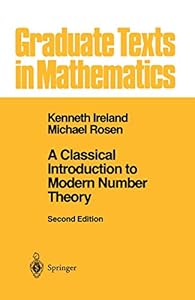#1,569 in Science & math books
Use arrows to jump to the previous/next product
Reddit mentions of A Classical Introduction to Modern Number Theory (Graduate Texts in Mathematics)
Sentiment score: 2
Reddit mentions: 2
We found 2 Reddit mentions of A Classical Introduction to Modern Number Theory (Graduate Texts in Mathematics). Here are the top ones.
or
Specs:
| Height | 9.25 Inches |
| Length | 6.1 Inches |
| Number of items | 1 |
| Release date | December 2010 |
| Weight | 2.7778245012 Pounds |
| Width | 0.93 Inches |

Number Theory. This starts out kinda easy but blows up in your face, I've been looking into L-functions a lot recently and they just make me feel so inadequate as a mathematician; contains exceptional amounts of Representation Theory, Functional Analysis, Real/Complex Analysis, Algebraic Geometry, Algebraic Number Theory, p-adic Analysis, Elliptic Curves, Automorphic Forms, Class Field Theory, Riemann-Roch Theory, Etale-Cohomology... crazy!
Anyhow, a lot of Algebraic Number Theory books spend a lot of time in the beginning defining Number Fields and extensions, going into ramification, splitting of primes etc. I think people need to learn a bit more about solving Diophantine Equations in Z and Q before looking at general number fields. So, if D(x_1,...,x_n)=0 is a Diophantine Equation, then we can look at D_p^k (x_1,...,x_n)=0, where everything reduced mod p^k . Clearly if D has a solution in Z, then each D_p^k will have a solution. Now, there are a lot of p^k 's, but luckily we can reduce the number of equations we have to check by looking at the p-adic fields. It turns out that D_p^k has a solution iff the D^p has a solution (where D^p is D considered as an equation in the p-adic field). So, this suggests that we try and figure out if an equation is solvable in all the p-adics, then is it solvable in Q?
It turns out that this is true, when D is quadratic (each term has total degree at most 2) with the added stipulation that D also have a solution in R, this is called the Hasse Principle. Fermat's Theorem gives a counter example for the case when the degree is greater than 2, since x^n +y^n -z^n =0 is solvable in all the p-adics and R. The appearance of R in this theorem is the first suggestion that something about R behaves like a prime, and it is generally treated as a "prime at infinity".
The thing I really want to call your attention to is the fact that we are looking at each prime individually to see if there is a solution on the whole. Looking at the p-adics means we are looking "locally", and looking at Q means we are looking "globally". This is justified in the sense that we can add a topology to the set of prime numbers that makes each prime a local entity and the whole of Z is the global thing. This kind of Local-to-Global principal is viral throughout mathematics, Category Theory formalized treatment like this with the concept of a Sheaf. I just think it is very cool that this extremely geometric principal, that lays the foundation for Differential Geometry (things are nice locally, so we see what happens there and figure out what we can extrapolate globally), has been very fruitful in the study of a field that (initially) seems as far as you can get from DG.
L-Functions, Zeta-Functions etc are studied by trying to express them locally in terms of primes to figure out their global properties. For example, the Riemann-Zeta Function is defined by a sum over all the powers of integers, but Euler proved that it can, instead be written as an infinite product of functions relating to the primes, giving a local interpretation to a function defined globally. Using this new Euler Decomposition, we can prove important analytic properties about the Zeta-Function and it's nifty functional equation (that secretly contains info about the "prime at infinity").
For more info on Number Theory, especially at the advanced undergrad level, I recommend A Classical Introduction to Modern Number Theory, great fucking book.
While you are probably not going to understand the gist of papers on number theory by reading an introductory book, the best book, to my mind, is Ireland and Rosen.